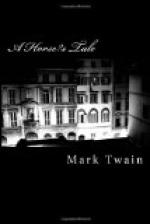Cathy thinks Dorcas is the best Catholic in America except herself. She could not pay any one a higher compliment than that, and Dorcas could not receive one that would please her better. Dorcas is satisfied that there has never been a more wonderful child than Cathy. She has conceived the curious idea that Cathy is twins, and that one of them is a boy-twin and failed to get segregated—got submerged, is the idea. To argue with her that this is nonsense is a waste of breath—her mind is made up, and arguments do not affect it. She says:
“Look at her; she loves dolls, and girl-plays, and everything a girl loves, and she’s gentle and sweet, and ain’t cruel to dumb brutes—now that’s the girl-twin, but she loves boy-plays, and drums and fifes and soldiering, and rough-riding, and ain’t afraid of anybody or anything—and that’s the boy-twin; ’deed you needn’t tell me she’s only one child; no, sir, she’s twins, and one of them got shet up out of sight. Out of sight, but that don’t make any difference, that boy is in there, and you can see him look out of her eyes when her temper is up.”
Then Dorcas went on, in her simple and earnest way, to furnish illustrations.
“Look at that raven, Marse Tom. Would anybody befriend a raven but that child? Of course they wouldn’t; it ain’t natural. Well, the Injun boy had the raven tied up, and was all the time plaguing it and starving it, and she pitied the po’ thing, and tried to buy it from the boy, and the tears was in her eyes. That was the girl-twin, you see. She offered him her thimble, and he flung it down; she offered him all the doughnuts she had, which was two, and he flung them down; she offered him half a paper of pins, worth forty ravens, and he made a mouth at her and jabbed one of them in the raven’s back. That was the limit, you know. It called for the other twin. Her eyes blazed up, and she jumped for him like a wild-cat, and when she was done with him she was rags and he wasn’t anything but an allegory. That was most undoubtedly the other twin, you see, coming to the front. No, sir; don’t tell me he ain’t in there. I’ve seen him with my own eyes—and plenty of times, at that.”
“Allegory? What is an allegory?”
“I don’t know, Marse Tom, it’s one of her words; she loves the big ones, you know, and I pick them up from her; they sound good and I can’t help it.”
“What happened after she had converted the boy into an allegory?”
“Why, she untied the raven and confiscated him by force and fetched him home, and left the doughnuts and things on the ground. Petted him, of course, like she does with every creature. In two days she had him so stuck after her that she—well, you know how he follows her everywhere, and sets on her shoulder often when she rides her breakneck rampages—all of which is the girl-twin to the front, you see—and he does what he pleases, and is up to all kinds of devilment, and is a perfect nuisance in the kitchen. Well, they all stand it, but they wouldn’t if it was another person’s bird.”




